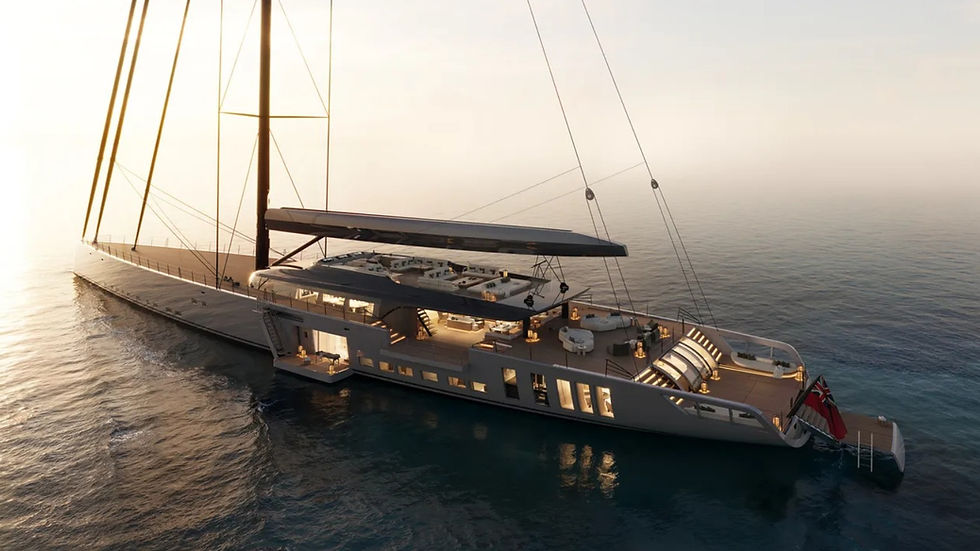The North Channel - Where Big Water Boating & Small Town Charm Coalesce
- Scott Way

- Mar 1, 2023
- 6 min read
Updated: Nov 8, 2023
With a seemingly ominous name like "The North Channel," you may conjure up images of a perilous maritime route with danger lurking beyond every turn, much like the fabled Northwest Passage. But don't let your imagination fool you -- the North Channel is one of Canada's best waterways.
As an east-west boater's paradise gouged into the almighty Canadian Shield, it presents 160 nautical miles of pristine nautical adventure. 'The Channel' runs parallel to the north shore of Lake Huron, with Manitoulin Island as the southern boundary and the Canadian mainland as the northern edge.
Despite the imaginations of its name, every boater should have a North Channel adventure on their bucket list. Here's why:
Some of Ontario's most pristine shoreline is here -- a constant stream of jaw-dropping geological formations and rocky outcrops built from jagged granite. In some places, southern limestone links up with the northern granite, creating unique geological structures and breathtaking views that aren't seen anywhere else in the world.
The northern shoreline, to the surprise of many, is actually an extension of the Niagara Escarpment, a UNESCO World Biosphere Reserve, from all the way in southern Ontario.
The biggest freshwater island on Earth, Manitoulin Island, provides the southern perimeter to the Channel. Despite being landlocked within North America, Lake Huron, upon which Manitoulin resides, is the third-largest freshwater lake in the world (behind its nearby neighbors Lake Michigan and Lake Superior). With its 30,000 islands, Lake Huron has the longest shore length of the Great Lakes, creating a crooked coastline full of quiet bays, privacy, and serenity.
It's the perfect place for boating, without the perils of saltwater and tides.
The North Channel also accommodates biodiversity unique to its locale. Its distinctive hawberries are found only on Manitoulin, where residents are colloquially known as "Haweaters." The annual Haweater Festival draws visitors from the mainland via the Little Current swing bridge, while boaters zip between her rotations to partake in one of the summer's best pitstops. Heck, they even have hawberry-flavoured beer. While you're moored, a climb up to Bridal Veil Falls is a relatively easy climb with a dazzling finale. A day at Providence Bay Beach is great for R&R, a stop at 10 Mile Point Lookout offers a breathtaking view, and a stroll along the Great Spirit Circle Trail will keep everyone energized.

To understand how, and why, the North Channel evolved with an explorer's ethos, one must first go back to the early 1600's. French colonial voyageurs travelling west into Lake Superior were the first to discover the east-west route across Manitoulin Island for commerce. With the fruits of that hard-earned labour, the first mission was established close to Wiikwemkoong in 1648, making French Jesuits the first recorded Europeans settlers in the region. The Jesuits called their new home ‘Isle de. Ste. Marie,’ which denotes the French connection to the nearby city of Sault Ste. Marie on the mainland to the west. In its modern form, Sault Ste. Marie sits at the edge of the St. Mary’s river and guards the passageway between the North Channel in the east and Lake Superior in the west (the same river also divides Canada to the north and the United States to the south). If you're going to venture into the ocean-like expanse of Lake Superior, it's best to stop in Sault Ste. Marie for some shore leave before entering the vastness of the almighty Superior.
Regardless of where you start, or finish, your North Channel experience, most folks encounter equal numbers of Canada and American boaters in their travels. If you're a transitory boater from Canada, Killarney in the eastern end of the Channel is an ideal location to start, with Little Current and Gore Bay being two other worthwhile options. Generally, Canadian boaters from southern Lake Huron and Georgian Bay tend to make up the majority of boats docked in Killarney, but you you'll also encounter plenty of U.S boaters in the midst of The Great Loop (also known as "Loopers"). This is a great opportunity not only to make new friends, but to also gather intel about changes in the water, the weather, and if you're lucky, the location of a good anchorage.
If you start in Killarney, you'll find a town with a charm that words can't describe. Entering Killarney harbour in the height of summer is unrivaled-- it's a classic harbourfront with a familial vibe. Killarney itself, like every pitstop on the Channel, has its own deep ties to Canadian history. In 1615, renowned explorer Samuel de Champlain settled the town and established a trading post. That made Killarney a pivotal location for French fur traders, and by the middle of the 18th century it served as a major commercial fishing centre. That personality and energy still resonates today.
The best fish 'n' chips in Ontario, if not Canada, may be at Herbert Fisheries. If you're hungry, just look down the harbourfront and you'll see it. It's hard to miss. If you time it right, you might even catch their boats bringing in the daily catch into the slip behind the store. If you're patient enough, they might even serve you that catch- deep fried and with a smile. If you've got time for layover, the Killarney Mountain Lodge is a modern experience -- but there's no hiding its charmingly rustic roots. The granite lookouts from nearby Killarney Provincial Park are also unmatched-- the view not unlike the Adirondack Mountains or the Catskills, just with a rugged Canadian flair.
Once its time to leave and get back underway, be sure to restock in Killarney. Careful preparations are essential to navigate the seemingly endless island chains in either direction. Don't hesitate to confer with locals to gather information about water levels, weather patterns, and anchorages. Asking inbound boaters as you're headed outbound will always be met with good info -- good boaters take care of good boaters.
If you've got the time and the means, it's well worth heading northwest from Killarney in the direction of Portage Cove and its stunning white granite outcropping. From there, head southwest to Heywood Island by following the clearly defined North Channel buoys. At Browning Cove, a well-liked overnight anchorage, you can socialize with travelers while enjoying epic sunsets over granite ridgelines. The Strawberry Island Lighthouse, which marks the settlement of Little Current up ahead, is your next stop. On a good day you can the lighthouse from Heywood Island.
During daylight, the Little Current swing bridge turns every hour on the hour. Once you scoot through, Little Current is all charm. If you forgot anything in Killarney, set aside some time here. If you visit Little Current in July or August, tune your VHF radio to channel 71 at 9 am for information and forecasts for transient boaters.
The north side of Clapperton Island, which has popular anchorages close either Croker Island or the Benjamin Islands, is the next stop. The Benjamin Islands are a premier summer destination thanks to the abundance of small inlets that offer peace and quiet to visiting boaters. On a hot summer day you can expect to see folks paddling kayaks or paddleboards as they venture out from their anchorage. Once you've experienced the Benjamin Islands, it's time to turn north towards Whales Back Channel.
You can continue down the channel until you reach Turnbull Island or Sanford Island, where you can anchor. The village of Blind River, which offers a complete range of gas, supplies, and activities, is the next stop if you continue past the islands. For its relative size, there are more restaurants and supermarkets in Blind River than any other hub on the Channel. The next leg of your journey, to the town of Thessalon, will likely be one of the longest of your North Channel journey. The second leg is similarly pleasant from Thessalon to McKay Island outside the town of Bruce Mines. If you're feeling fatigued from travel, and you probably will be, de-boarding in Bruce Mines is a great remedy.
If you touch the grass in Bruce Mines and find you're feeling peckish head over to Bobber's Restaurant. They'll know you're not a local, but that usually leads to friendly conversation and the typical 'where ya headed?' lines of questioning. If you're staying overnight, the Bavarian Inn offers lodging and excellent schnitzel commensurate with its Germanic roots. Many boaters use Bruce Mines as their turning point before heading back eastward towards Killarney, so mind your map if you're thinking the same.
If you choose to keep heading west, the St. Mary's River, which leads to the city of Sault Ste. Marie and Lake Superior, lies ahead. The beautiful and deceptively large St. Joseph's Island sits to the south. For many boaters, the circling St. Joseph's Island is a leisurely roundabout before heading back east. As part of the roundabout you'll also pass beneath Gilbertson Bridge, which connects St. Joseph's island to the mainland, and it will undoubtedly summon a few thoughts about continuing west to Lake Superior rather than admitting you've turned the proverbial corner.
Because of fluctuating wind and weather, in many cases boaters use the same route to return home as it guarantees safe passage from the lessons learned on the trip west. If, however, you took the time to chit-chat with a Looper at Bobber's or a fisherman in Killarney, you might have new anchorages and honey holes to scout.
The North Channel is the perfect encapsulation of the Canadian boating experience as it's a charmingly perfect blend of big water cruising paired with small town charm. The North Channel has it all, from cruising the vast expanses of the Great Lakes, to getting a tan topside while anchored in a tiny harbour. This summer, set aside the time to experience 160 nautical miles of Canada's best boating.






























Comments